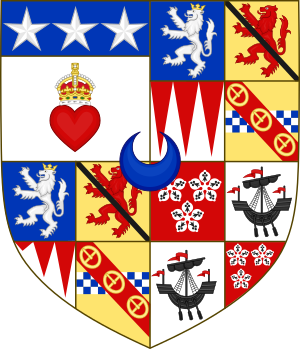Charles Douglas, 2nd Earl of Selkirk facts for kids
Quick facts for kids
The Earl of Selkirk
|
|
|---|---|

Arms of Lord Selkirk
|
|
| Governor of Edinburgh Castle | |
| In office 1737–1738 |
|
| Preceded by | The Earl of Orkney |
| Succeeded by | The Lord Ross |
| Representative Peer for Scotland | |
| In office 1722–1739 |
|
| In office 1713–1715 |
|
| Lord Clerk Register | |
| In office 1733–1739 |
|
| Preceded by | The Earl of Marchmont |
| Succeeded by | The 3rd Marquess of Lothian |
| In office 1696–1702 |
|
| Preceded by | Sir Thomas Burnett, Bt |
| Succeeded by | The Lord Philiphaugh |
| Personal details | |
| Born |
Lord Charles Hamilton
3 February 1663 |
| Died | 13 March 1739 (aged 76) London, England |
| Relations | James Hamilton, 1st Duke of Hamilton (grandfather) William Douglas, 1st Marquess of Douglas (grandfather) James Hamilton, 4th Duke of Hamilton (brother) |
| Parents | William Douglas, 1st Earl of Selkirk (father) Anne Hamilton, 3rd Duchess of Hamilton (mother) |
Charles Douglas, 2nd Earl of Selkirk (born Lord Charles Hamilton; 3 February 1663 – 13 March 1739) was an important Scottish nobleman and a member of the royal court. He held several high-ranking positions throughout his life, serving different kings of Great Britain.
Contents
Early Life and Family
Charles Hamilton was born on 3 February 1663. He was the second surviving son of William Hamilton, Duke of Hamilton and Anne Hamilton, 3rd Duchess of Hamilton. His mother, Anne, was a Duchess in her own right, meaning she inherited the title herself.
Charles had many brothers and sisters. His older brother, James Hamilton, 4th Duke of Hamilton, also became a very important figure. Charles's family was well-connected, with grandfathers who were Dukes and Marquesses.
In 1682, when he was about 19, Charles traveled to France with a tutor. Two years later, his older brother James joined him. Together, they went to see the army of the King of France during a siege (a military blockade) of Luxembourg. This was an early experience with military and political life for Charles.
Political Career and Royal Service
Charles Douglas had a long and active career in public service. In 1688, he was made a colonel in the army, though he only held the position for a month. He supported the "Revolution of 1688," which brought William III to the throne. Charles even joined William III at the Battle of the Boyne in 1690, a major battle in Ireland. He also went on several military campaigns in Europe.
He served as a Lord of the Bedchamber for many years. This was a trusted position, where he attended to the king's personal needs and was part of the royal household. He served William III from 1689 to 1702. Later, he served George I and George II from 1714 until his death in 1739.
Charles also held several important government roles:
- He was a Burgess of Edinburgh around 1692, which meant he was a citizen with special rights in the city.
- He served as Lord Clerk Register twice, from 1696 to 1702 and again from 1733 until 1739. This role involved keeping public records in Scotland.
- He was a Lord of the Scottish Treasury from 1704 to 1705, helping manage Scotland's money.
- He was a Sheriff-Principal of Lanarkshire, a legal and administrative role in a specific region.
Opposing the Union and Becoming a Peer
Charles strongly disagreed with the Treaty of Union, which joined Scotland and England into Great Britain in 1707. Despite his opposition, he became a Representative Peer for Scotland. This meant he was chosen to represent Scottish nobles in the British Parliament. He served in this role from 1713 to 1715 and again from 1722 until his death.
In 1733, he became a member of the Privy Council of Great Britain. This is a group of trusted advisors to the King. From 1737 to 1738, he served as Governor of Edinburgh Castle, a very important historic fortress in Scotland.
Inheriting the Earldom
Charles inherited the title of Earl of Selkirk from his father. His father, William, was first given the title of Earl of Selkirk in 1646. Later, William became the Duke of Hamilton through his marriage to Anne. To make sure the Selkirk title continued, William gave up the Earldom of Selkirk. The King then granted it to Charles and his younger brothers. This meant that if Charles or his brothers became Duke of Hamilton, the Earldom of Selkirk would pass to the next younger brother.
When his father died in 1694, Charles became the 2nd Earl of Selkirk. At this point, he changed his last name from Hamilton back to Douglas, which was his father's original family name.
Later Life and Legacy
Lord Selkirk never married. He passed away in London on 13 March 1739, at the age of 76. After his death, his younger brother, John, became the next Earl of Selkirk.
Charles Douglas, 2nd Earl of Selkirk, was buried in Westminster Abbey in London. This is a very famous church where many important British figures are buried.

